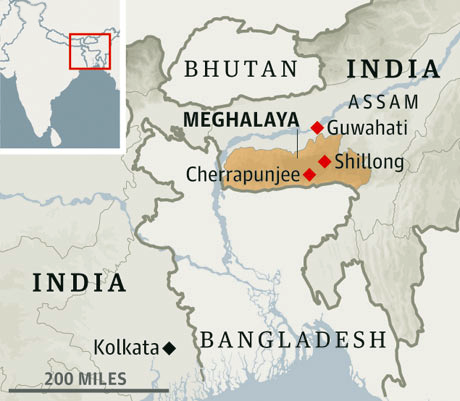Geography
Declining Rainfall in Cherrapunji
- 22 Feb 2021
- 5 min read
Why in News
A recent study that looked at the rainfall pattern in the past 119 years found a decreasing trend at Cherrapunji (Meghalaya) and nearby areas.
- The village of Mawsynram in East Khasi Hills district of Meghalaya has beaten Cherrapunji to become the wettest place in the world. Mawsynram receives over 10,000 millimetres of rain in a year.
- Mawsynram is located around 81 km by road from Cherrapunji however the straight line distance between the two is 15.2 km.
Key Points
- Reduction in Rainfall:
- The annual mean rainfall for the period 1973–2019 showed decreasing trends of about 0.42 mm per decade.
- It was statistically significant along seven stations (Agartala, Cherrapunji, Guwahati, Kailashahar, Pasighat, Shillong and Silchar).
- The annual mean rainfall for the period 1973–2019 showed decreasing trends of about 0.42 mm per decade.
- Reasons:
- Rising Temperature:
- The changes in the Indian Ocean temperature have a huge effect on the rainfall in the region.
- Increasing sea surface temperatures in the tropical Indian Ocean region was pointed out by the first climate change assessment report published by the Union Ministry of Earth Sciences in June 2020.
- The changes in the Indian Ocean temperature have a huge effect on the rainfall in the region.
- Increased Human Activities:
- The satellite data showed that there was a reduction in the vegetation area in northeast India in the past two decades, implying that human influence also plays an important role in the changing rainfall patterns.
- The traditional way of cultivation known as Jhum cultivation or shifting cultivation is now decreased and being replaced by other methods.
- There is sizable deforestation in the region. The study saw the decrease in vegetation cover and increase in the areas of cropland mainly from the year 2006 onwards.
- The analysis showed reductions in vegetation with 104.5 sqkm lost per year.
- On the other hand, there were significant increases in cropland (182.1 sqkm per year) and urban and built-up lands (0.3 sqkm per year) during the period 2001–2018.
- The satellite data showed that there was a reduction in the vegetation area in northeast India in the past two decades, implying that human influence also plays an important role in the changing rainfall patterns.
- Rising Temperature:
- Significance of Studying the North-East Region:
- Since north-east India is mostly hilly and is an extension of the Indo-Gangetic Plains, the region is highly sensitive to changes in regional and global climate.
- It has to be noted that the first signs of the effect of climate change will be evident for the extreme cases such as the rainfall at Cherrapunji.
- North-east India has the highest vegetation cover in India and includes 18 biodiversity hotspots of the world, indicating the importance of the region in terms of its greenery and climate-change sensitivity.
Reason for High Rainfall in Cherrapunji and Mawsynram
- Cherrapunji (elevation 1313 m) and Mawsynram (elevation 1401.5 m) are located on the southern slopes of the east Khasi Hills in Meghalaya.
- Meghalaya is a mountainous state with numerous valleys and highland plateaus.
- Elevation in the plateau region ranges between 150 m to 1,961 m , with the central part comprising the Khasi Hills with the highest elevations.
- The rainfall in Cherrapunji-Mawsynram is caused by the orography favouring a monsoon wind regime.
- The northward moving moist winds from the Bay of Bengal passing over the plains of Bangladesh are forced to converge in the narrow valleys of the Khasi Hills with orography providing forced ascent that causes condensation, formation of clouds resulting in rain on the windward side of the slope.
Shifting Cultivation
- Shifting cultivation, locally called 'Jhum', is a widely practiced system of crop cultivation among the indigenous communities of North-east India. The practice, also known as slash-and-burn agriculture, is when farmers clear land by slashing vegetation and burning forests and woodlands to create clear land for agricultural purposes.
- This provides a very easy and very fast method of the preparation of the land for agriculture.
- The bush and the weeds can be removed easily. The burning of waste materials provides needed nutrients for the cultivation.
- It gives a family its food, fodder, fuel, livelihood and is closely linked to their identity.
- Because of cutting of forests and trees, this practice leads to soil erosion and may also affect the course of rivers.





